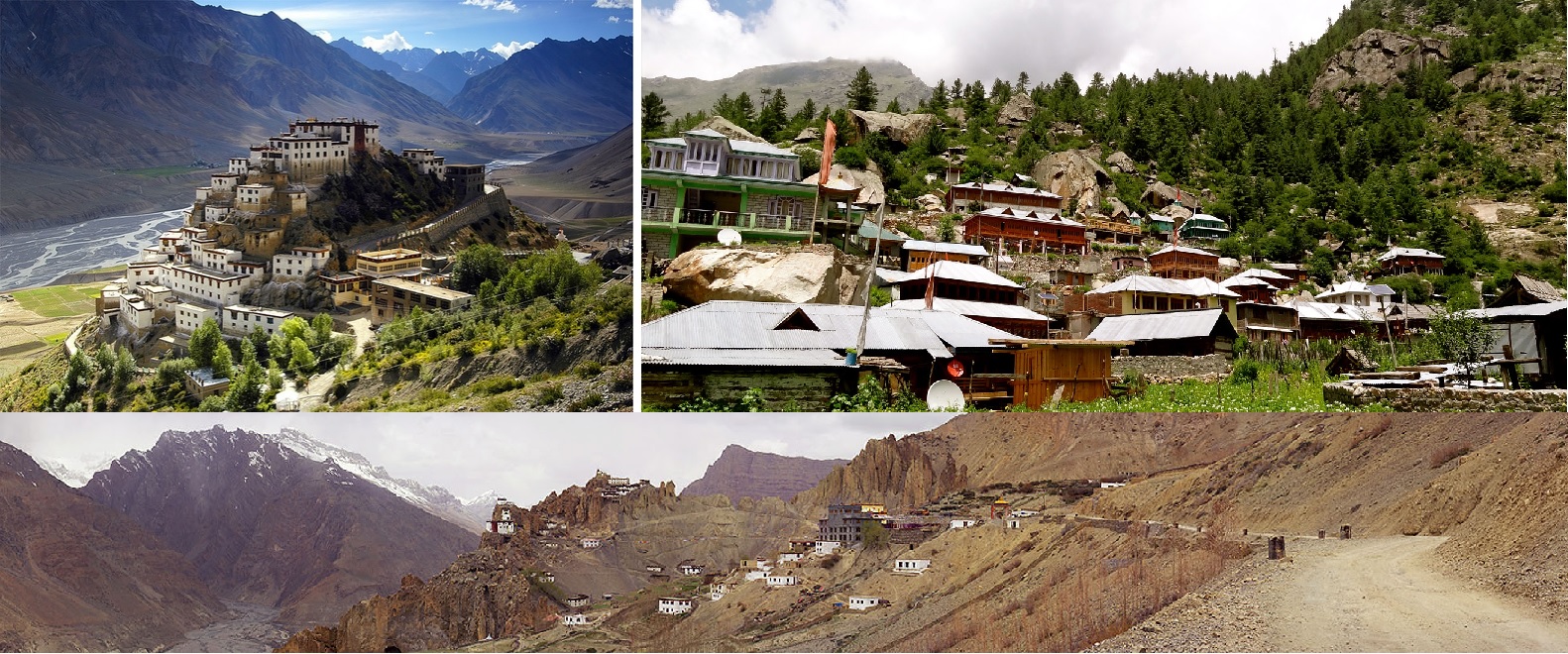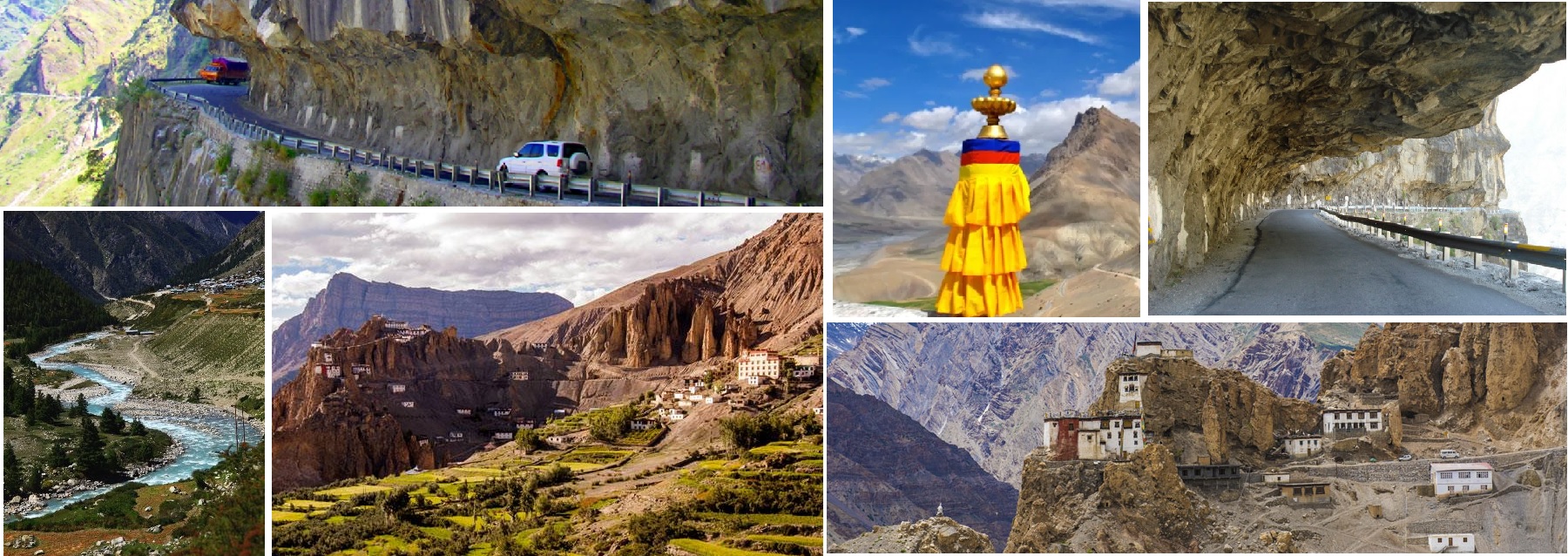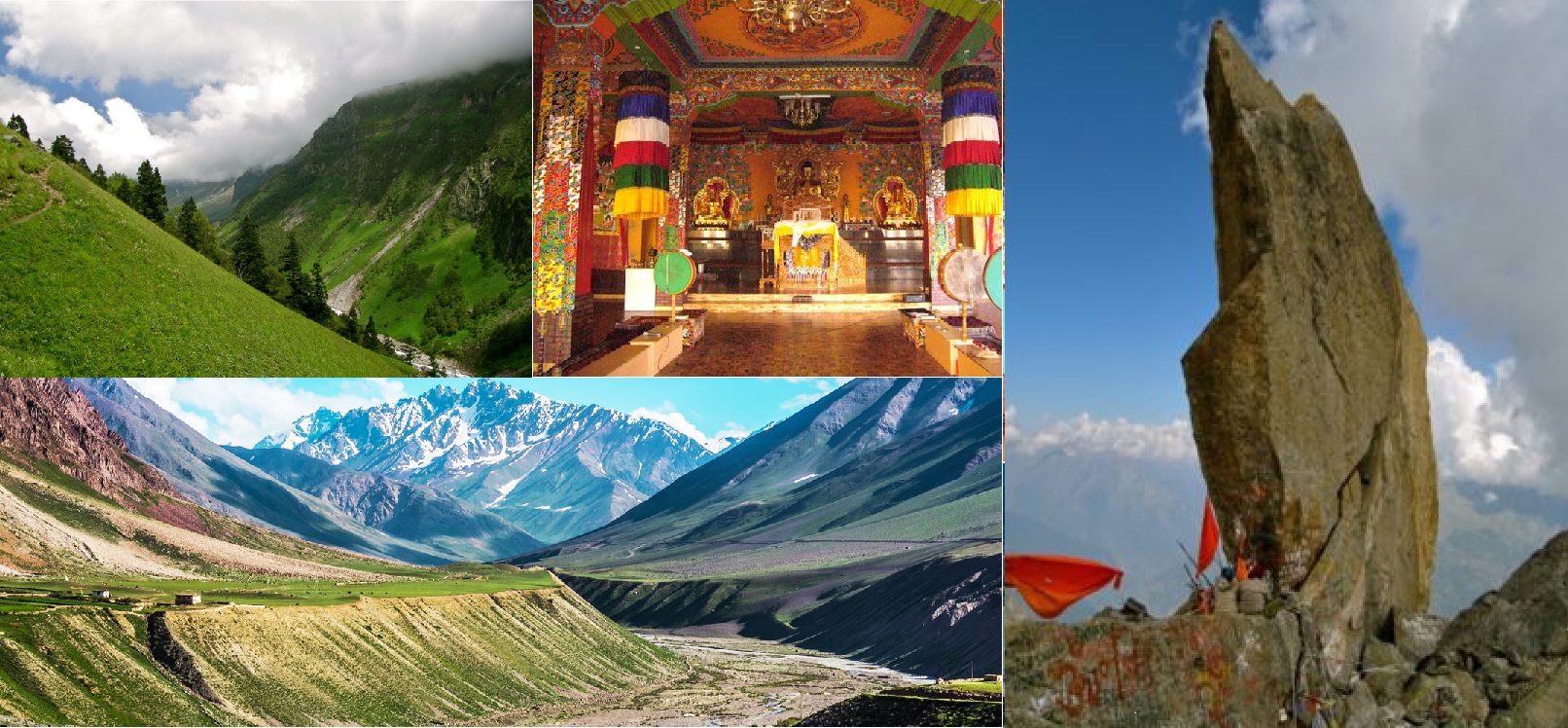LAHAUL SPITI
Tour Description
Lahaul Spiti
Day 01 Chandigarh – Narkanda (175 kms – 06 hrs)
Xxx hrs arrive Chandigarh airport / railway station
Leave for Narkanda. Enroute Pass through Solan and Shimla
On reaching Narkanda, check-in at hotel / resort
Narkanda - Situated at an attitude of 2708 meters on the Hindustan Tibet road (NH – 22), Narkanda offers a spectacular view of snow ranges. This is an ideal retreat for the tourists who seek seclusion in mountains. It commands an unique view of the eternal snow line, the inviting apple orchards and dense forests. Narkanda is also a gateway to apple country of Himachal Pradesh. .
Evening – at leisure
Overnight in Narkanda
Day 02 Narkanda – Sangla enroute – visit Sarhan (230 kms )
After breakfast at hotel, leave for Sangla. Enroute visit famous Bhimakali temple in Sarhan
2165 meters above the sea level, Sarahan commands a view of Srikhan Mahadev Peak and is famous for its 800 years old Bhimkali Temple (one of the 51 Shaktipeeths), one of the best examples of Hill Architecture. In the evening, enjoy panoramic views of the Shrikhand Peaks.
Thereafter, follow the course of the Sutlej River to Karcham 1899mts where it is joined by the Baspa (Sangla) flowing from the east
En-route you cross Taranda 1800mts cliffs a breathtaking sight, where the road is cut straight through a rock. Arrive Sangla and transfer to hotel.
Sangla (also known as Baspa Valley) is a picturesque hill town situated in the Kinnaur District of Himachal Pradesh. Located in the valley of Baspa, this place lies in proximity to the Tibetan border. The town has been named after a village of the same name, which means 'Pass of Light' in the Tibetan language. The scenic beauty of the region is mesmerising as it rests in the Greater Himalayas and is enveloped with forest slopes and mountains.
Overnight in Sangla
Day 03 Sangla – Rakcham – Chitkul – Sangla
Breakfast at hotel.
Sangla - explore the ancient Kamru Fort and Temple which is dedicated to the Goddess Kamakhya Devi which was brought from Assam. Also visit Nag Temple, Monasteries, Trout Firm
After lunch, leave for an excursion to Chitkul, the last Village on an old Indo-Tibetan trade route. Walk through the green orchards and enjoy the serenity as a brilliant stream passes by.
As the day ends, return to the hotel in Sangla for dinner and a comfortable overnight stay.
Overnight in Sangla
Day 04 Sangla – Nako (168 kms )
via - Kalpa – Rarang – Jangi – Morang – Labrang – Kanam – Ropa – Puh – Khab)
Breakfast at hotel.
Your journey today, is to a region which was opened to tourists only a few years ago. From lower Kinnaur to upper Kinnaur, it’s a transition in the landscape, beliefs and life styles, a 150 km journey into the history and culture of Kinnaur. You follow the old HT road from Kalpa towards Spillo and then the transition starts as you reach Khab the place where Spiti River meets Sutlej. Across the Ka loops and you reach Nako, like an oasis in the desert.
On reaching, transfer to hotel.
Overnight in Nako
Day 05 Nako – Mudh via - Tabo – Dhankar – Kungri (150 kms )
Breakfast at hotel.
Today you depart for Nako crossing the treacherous stream. The road descends gradually to the riverside and continues up to Chango village at 3100mts. Five kilometers from here the National Highway crosses to the right bank of the Spiti river above which lies Shialkhar. Eight kilometers past Shialkhar the road crosses the river again and Kinnaur is past us. This is Sumdo where the Parechu coming from Tibet meets the Spiti. Here the road (NH) wanders away from the river to end near Kaurik and the Sumdo – Kaza road assumes the role of guiding the traveler up the valley of Spiti. This area of Spiti is known as Sham.
Visit Hurling - 3125 mts. is the first village of Spiti.
Further 4 kms visit the pride of Spiti “The Tabo Monastery” 3280mts..
Enroute you also visit the ancient Mummy at Giu.
Almost 20kms away from Tabo is Sichling 3,400mts. from where a 7km link road climbs sleepily to Dhankar 3,700mts, high up on the left bank. Dhankar was Spiti’s old capital and wedged between the rocky, pinnacles on the eastern face are its old buildings. Manerang Peak 6593mts. is seen to advantage from Dhankar. A stiff climb of less than an hour brings us to Dhankar Lake which seems tiny despite a 2 km circumference amidst the vast undulating pastures surrounding it. Later we can drive to Mudh enroute we can stop at Kungri Monastry and drive to Mudh. This is the entry point for Pin Parvati valley from Spiti ans ending point of those peoples who enters Pin Valley from Banjaar.
On reaching, transfer to hotel.
Overnight in Mudh
Day 06 Mudh – Kaza (168 kms )
Breakfast at hotel
Visit the village of Mudh. Enjoy the serenity of Pin valley. Here you can also visit Mudh Gompa and see how local peoples are living their life happily.
Early afternoon start drive to Kaza,
On arrival check in at hotel.
Evening free to explore local market and famous monastery of Kaza. Kaza is the headquarter of Spiti valley, all administrative offices are here . We can say this is the hub for Spiti valley for all eatables and shoppings.
Overnight in Kaza
Day 07 Kaza – Langza – Komic – Kaza
Breakfast at hotel
Later leave on full day excu8rsion to Langza & Komic
Langza is also considered to be one of the highest villages in the world with a motorable road. Owing to its proximity to Tibet in China, the population of the village is predominantly Buddhist and belongs to the Sakyapa sect of Tibetian Buddhism. The village has a population of about 137 people living in 33 houses. Langza is divided into two sections; Langza Yongma (Lower) and Langza Gongma (Upper). The main occupation of the villagers in the olden days was mud craft. This art prevails in the village to this day. Vessels of all shapes and sizes are produced and sold all across the country. Agriculture is another major occupation in this village. Crops such as rice and potatoes are cultivated here. At first glance of the village, one will instantly notice a huge Golden coloured Buddha statue which is believed to be around 1000 years old. All the houses in the village are built below this statue. The houses are made of mud and have prayer flags tied around them.
Overnight in Kaza
Day 08 Kaza – Kie – Kibber (154 kms – 04 hrs)
After early breakfast at hotel, leave for Kibber
Enroute visit Kie Monastry
Kye Gompa is said to have been founded by Dromtön, a pupil of the famous teacher, Atisha, in the 11th century. This may however, refer to a now destroyed Kadampa monastery at the nearby village of Rangrik, which was probably destroyed in the 14th century when the Sakya sect rose to power with Mongol assistance.
The walls of the monastery are covered with paintings and murals, an example of the 14th century monastic architecture, which developed as the result of Chinese influence. Kye monastery has a collection of ancient murals and books, including Buddha images. There are three floors, the first one is mainly underground and used for storage. One room, called the Tangyur is richly painted with murals. The ground floor has the beautifully decorated Assembly Hall and cells for many monks.
Continue drive to Kibber, on arrival check in at hotel.
Kibber is a village high in the Spiti Valley in the Himalayas at 4270 metres or 14,200 ft in Himachal Pradesh in northern India. It contains a monastery and the Kibber Wildlife Sanctuary. Kibber lies in a narrow valley on the summit of a limestone rock. Agriculture forms the backbone of the local economy and lush green fields are abundant. Villagers count on the 3 day traditional trade route over Parang La to Ladakh to barter their horses for yaks or to sell for cash.
The Kibber Wildlife Sanctuary was established in 1992, which spans over an area of 2,220.12 sq.km of land. The elevation range of this sanctuary is 3,600-6,700 m above mean sea level. The vegetation here is sparse and have high medicinal properties. This sanctuary has been extensively surveyed by C.P. Kala for distribution of plants and their indigenous uses as established by the amchis - the practitioners of Tibetan medical systems. Eight rare and endangered medicinal plant species have been discovered by C.P. Kala from this sanctuary. Aconitum rotundifolium, Arnebia euchroma, Ephedra gerardiana, Gentiana kurroo and Dactylorhiza hatagirea are such threatened but medicinally important plants occur in this sanctuary.
Evening stroll around the village and admire the beauty of highly situated village and see the local culture.
Overnight: in Kibber
Day 09 Kibber – Chandratal Lake (83 kms - 03 hrs)
After breakfast, leave for Candratal
Enroute cross the Kunzum Pass . Along the main road 6Kms. from Kaza is Rangrik 3680mts backed by the jagged, rocky cliffs on the right side of the valley followed by the green oasis of Khurik 3750mts Sumling 3750 and Moorang 3775mts after which Gyundi flows into Spiti. You enter the least populated part of the Spiti Valley called Tud shortly after Losar 4079mts the highest village in this part is only 22Km from Kunzum Pass 4807mts. This is the most outstanding sight in Tud, the view from Kunzum top. The flower bedecked slopes in the foreground are backed by an awesome vista of rocky massifs and hanging glaciers in the Lahaul Valley. Near Losar the confluence of the three tributaries which form the Spiti is impressive. The way to Chandtratal. The moon lake begins from Batal further down Kunzum in the Chandra Valley.
Overnight: in Chandratal
Day 10 Chandratal lake – Chattru – Rohtang Pass – Manali (123 kms )
Breakfast at Camp
Follow the Chandra River through some of the most beautiful mountain scenery. The road is mostly dirt track. Taking it easy you are headed to Chattru, crossing Chotta Dhara. This place is an interesting geological zone for studies as three mountain ranges meet here and the formations are some of the most amazing in the whole world. Further down the Chandra valley, facing some steep cliff walls is Chattru a temporary campsite erected for the intrepid travelers to this land. Along the side the of the Chandra river we drive past Gramphoo just below the Rohtang pass. Ascend to the Rohtang Pass, and then descend towards Manali.
On reaching transfer to hotel
Overnight: in Manali
Day 11 Manali – Chandigarh – airport
Early morning leave for Chandigarh
On reaching transfer to airport / railway station
Tour Ends
HIGHLIGHTS
- ​Visit the remote villages of Hikkim, Mud and Kibber, few with population of as less as 15 families
- Ride through the historic Hindustan – Tibet highway and be transported back in time
- Explore the border roads of India in Chitkul and Nako, riding as close as 5 kms along the Tibet border.
- Watch one of the best sunrise and sunset over the Himalayas in Kalpa
- Experience the rich culture of Kinnaur Valley in its purest form
- Visit some of the largest and oldest monasteries in Spiti
- Visit the 1000 year old Kumru Fort, one of the oldest in Himachal Pradesh
- Get an epic view of the Kinner Kailash peak in Kalpa
- Ascend two very treacherous passes- Rohtang La (3979 m) and Kunzum La (4590 m)



